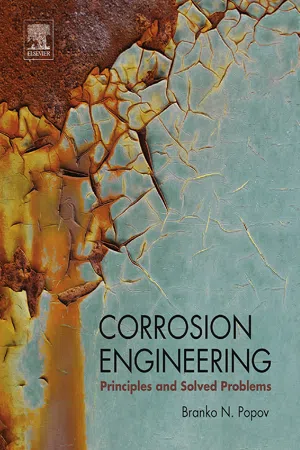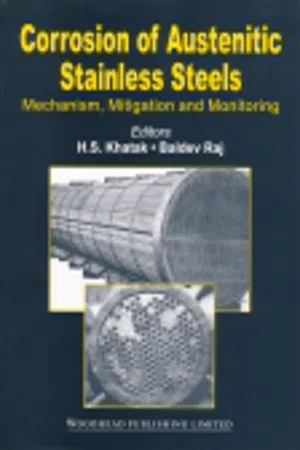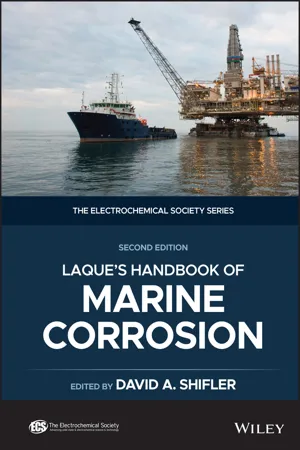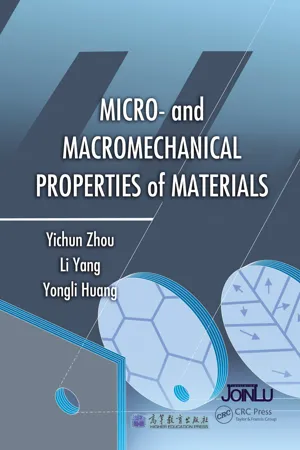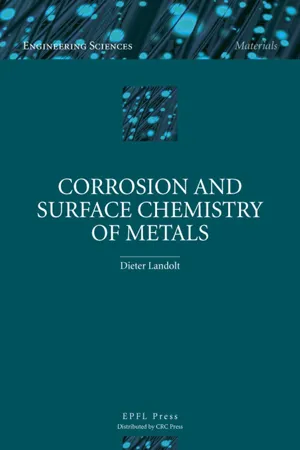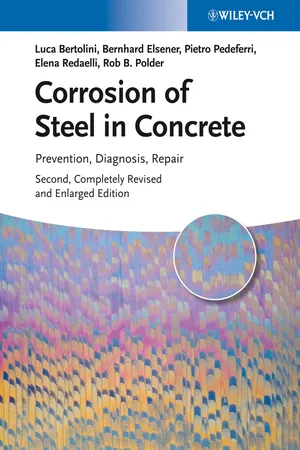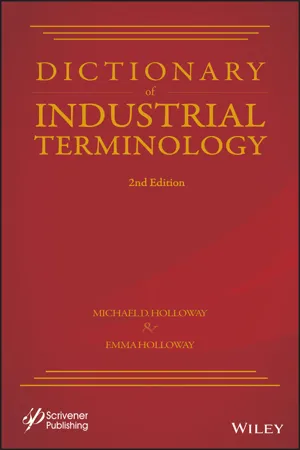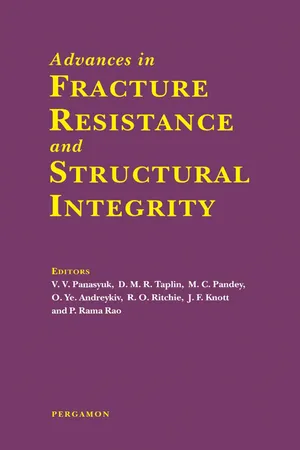Technology & Engineering
Stress Corrosion Cracking
Stress corrosion cracking is a type of corrosion that occurs under tensile stress in the presence of a corrosive environment. It can lead to the sudden failure of materials, particularly metals, and is a significant concern in engineering and infrastructure. The combination of stress and corrosion can cause cracks to propagate rapidly, compromising the integrity of the affected material.
Written by Perlego with AI-assistance
Related key terms
1 of 5
10 Key excerpts on "Stress Corrosion Cracking"
- eBook - PDF
- Zheng-Ming Huang, Sayed Hemeda, Zheng-Ming Huang, Sayed Hemeda(Authors)
- 2019(Publication Date)
- IntechOpen(Publisher)
Chapter 3 Stress Corrosion Cracking Damages Alireza Khalifeh Abstract Stress Corrosion Cracking (SCC) is the formation and growth of crack through materials subjected to tensile stress and a specific corrosive medium. It can lead to unexpected sudden failure of normally ductile metals. Metal-environment combi-nations susceptible to cracking are specific. This means that all environments do not cause SCC on all of the alloys. Additionally, the environments that cause this kind of cracking have little corrosion effect on the alloy in normal conditions. In certain states, unwanted environmental and metallurgical changes have occurred and pro-vide the metal-environment combination sensitive to SCC. The SCC sites on the metal surfaces may not be visible by visual inspection, while metal parts are being filled with microscopic cracks. These invisible cracks progress rapidly and lead the component and structures to catastrophic failures. In this chapter, the incidence of SCC on important industrial alloys from the chemical, metallurgical, and mechani-cal point of view is discussed. Keywords: Stress Corrosion Cracking, environments, materials, mechanisms, fracture mechanic 1. Introduction Stress Corrosion Cracking (SCC) in chemical, petrochemical, and power plant industries is an insidious form of corrosion, which causes a lot of financial losses and human damages [1 – 5]. This phenomenon is associated with a combination of tensile stress, environment, and some metallurgical conditions as described in Figure 1 . During Stress Corrosion Cracking, the metal or alloy is virtually unattacked over most of its surface, while fine and branch cracks progress through the bulk of material [6]. It is shown in Figure 2 . This cracking phenomenon has serious conse-quences since it can occur under stresses much lower than design stresses and lead the equipment and structures to premature failures [7 – 11]. - eBook - ePub
Corrosion Engineering
Principles and Solved Problems
- Branko N. Popov(Author)
- 2015(Publication Date)
- Elsevier(Publisher)
Chapter 9Stress Corrosion Cracking
Abstract
This chapter begins with a Stress Corrosion Cracking (SCC) definition and characteristics, testing methods common to SCC and hydrogen-induced cracking, fracture mechanics principles and techniques, and corrosion fatigue testing. SCC metallurgy is explained through case studies on SCC variables such as solid solution composition, grain boundary segregation, alloy phase transformation and associated solute depleted zones, duplex structures, and cold work. Electrochemical effects have been analyzed through case studies published between 2000 and 2013 by more than 200 references. The SCC fundamental principles, nature of the processes, and the protection strategies are explained through solved exercise problems from fracture mechanics and case studies published in the last decade.Keywords Stress Corrosion Cracking (SCC) SCC metallurgy Electrochemical effects Hydrogen embrittlement Corrosion fatigue failure SCC preventionChapter Contents9.1 Definition and Characteristics of Stress Corrosion Cracking 3669.2 Testing Methods 3679.2.1 Constant deformation tests 3689.2.2 Sustained load tests 3749.2.3 Slow strain rate tensile testing 3749.3 Fracture Mechanics Testing 3769.3.1 Test methods 3799.3.2 Precracked cantilever beam specimens 3809.3.3 Linearly increasing stress test 3829.4 Examples of Stress Corrosion Cracking 3839.5 SCC Models 3839.5.1 Film rupture model 3859.5.2 Fracture-induced cleavage model 3869.5.3 Localized surface plasticity model - eBook - PDF
Corrosion of Austenitic Stainless Steels
Mechanism, Mitigation and Monitoring
- H S Khatak, B Raj(Authors)
- 2002(Publication Date)
- Woodhead Publishing(Publisher)
In such materials, localized breakdown of the passivity by mechanical means (stresses present in the material) can lead to accelerated attack in a very narrow region, the rest of the area still remaining protected. A general definition of the phenomenon is that SCC is the fracture of a material by the simultaneous action of a tensile stress and a corrosive environment. It is a synergistic process in the sense that the time-to-fracture, the decrease in load-bearing capacity, and other effects manifested in the phenomenon, are different from similar effects by stress or corrosion acting alone. The phenomenon is of great industrial significance since stresses are invariably induced during the fabrication of plant components and structures and it is not always possible to remove the stresses or to make reliable measurements of it in the engineering structures. The phenomenon of general corrosion (uniform corrosion), by which a material either dissolves 'Scientific Officer, Corrosion Science and Technology Division, Indira Gandhi Centre for Atomic Research, Kalpakkam-603 102, India. 140 MLIRALEEDHAHAN away more or less uniformly or the surface layers are converted into scales of corrosion products (e.g., rusting of iron), is fairly well known. - eBook - PDF
- David A. Shifler(Author)
- 2022(Publication Date)
- Wiley(Publisher)
239 LaQue’s Handbook of Marine Corrosion, Second Edition. Edited by David A. Shifler. © 2022 John Wiley & Sons, Inc. Published 2022 by John Wiley & Sons, Inc. 10.1 Introduction The principal effects of stress on the performance of materials in marine environment take the form of environmentally induced or environmentally assisted cracking (EAC) (Jones 1996). Stress Corrosion Cracking is a term frequently used with the acronym SCC (ASTM 2020). Stress can also effect dealloying and intergranular corrosion as discussed in other chapters, but it generally has limited effect on most other forms of corrosion of engineered materials in seawater. EAC can occur under static stress whether applied or residual (SCC and hydrogen embrittlement [HE]) and in the form of corrosion fatigue cracking (CFC) under cyclic loading (ASTM 2020). EAC can occur in highly ductile materials yet result in brittle cracking. For instance, EAC generally occurs at stresses below the yield strength, and the threshold stress intensities K ISCC below the dry fracture toughness (K IC ), where the stress intensity factor (SIF) described here applies to the case of mode I loading. EAC is often plotted as crack growth velocity versus SIF. The lower limit of cracking is referred to as K ISCC , while the upper limit is K IC in mode one loading. In between these two limits, three stages are observed. In Stage I, cracking is a strong function of SIF. In Stage II, it is a strong function of environmental severity, and in Stage III, it is a mixed function of environmental and mechanical driving forces. Likewise, during CFC, cracking in natural environments cracking occurs at cyclic stresses below the yield strength of the material, and at cyclic threshold stress intensity amplitudes in precracked materials below the cyclic threshold stress intensity amplitude for fatigue cracking in dry air or vacuum. This mode of degradation is discussed in a separate chapter. - Yichun Zhou, Li Yang, Yongli Huang(Authors)
- 2013(Publication Date)
- CRC Press(Publisher)
Stress Corrosion Cracking refers to embrittlement cracking that occurs on a material under the combined action of specific corrosive media and static stress. SCC is not a simple summation of stress and corrosive media, but cracking that occurs according to a special mechanism under their combined action. Generally, a small stress is required when SCC occurs. If the material is not in a specific corrosive media, however, cracking will not occur under a small stress. But even if no stress exists, the material will still suffer from a small amount of corrosion in this environmental media. The reason why SCC is dangerous is that it often occurs in relatively mild media, and in a relatively low stress state where no obvious potential signs of cracking appear. As a result, SCC often leads to a catastrophic accident.Generally, SCC has the following characteristics. It is static stress, usually in the form of tensile stress that results in stress corrosion fracture. It is much lower than the material’s yield strength. The higher the tensile stress, the shorter the cracking time becomes. From recent research, we find that [1 –4 ], under pressure stress, SCC also occurs in stainless steel, aluminum alloys, and copper alloys. However, it is longer than tensile stress-induced corrosion by 1–2 orders of magnitude with respect to the initiation time and is also different from tensile stress-induced correction in the fracture shape. It should be noted that the stress may be external stress or residual stress [5 ,6 ].The fracture resulting from stress corrosion is embrittlement cracking, without obvious plastic deformation.Stress corrosion in heavy metals or alloys only occurs in specific media. For example, corrosion fracture occurs on α brass in ammonia solution, while it occurs on β brass in water. Similarly, austenitic stainless steel has high SCC susceptibility (generally called chloride embrittlement) in chloride, while ferrite stainless steel is susceptible to chloride solution. For the combination of SCC susceptible materials and media, see Table 8.1 [7 –10 ].The crack growth of stress corrosion is slow, at a rate of10to- 910m / s- 6- eBook - PDF
- Dieter Landolt(Author)
- 2007(Publication Date)
- EPFL Press(Publisher)
CHAPTER 11 ENVIRONMENT INDUCED CRACKING 11.1 INTRODUCTION In certain environments, metals crack or rupture at stress levels significantly lower than their ultimate tensile strength, or even their elastic limit. The phenomenon is known as environment induced cracking (EIC). The terms environment sensitive cracking or environment assisted cracking are also sometimes used in the literature. To some extent, EIC phenomena are also observed with ceramics and polymers, but they are in general less of a problem and the underlying mechanisms differ from those found with metals. The particular importance of EIC of metals is due to the fact that load bearing structures for critical applications are usually made of metal. Indeed, EIC of metals is a major concern in many technological areas, including chemical and petroleum industries, nuclear power generation, aero-space and civil engineering. In all these applications, an unexpected rupture can lead to accidents with catastrophic consequences for human life and the environment. Design engineers must therefore take into account the fact that if a structure is exposed to corrosion conditions that favor crack formation and growth its mechanical resistance will significantly diminish with time. Environment induced cracking of metals includes the following phenomena: • Stress Corrosion Cracking; • hydrogen embrittlement; • corrosion fatigue. Stress Corrosion Cracking (SCC) is caused by the combined action of a static tensile stress and corrosion. The stress may originate from external loading or be the result of a thermal or mechanical treatment that generates residual stresses in the material. Stress Corrosion Cracking failures usually occur with some delay and they are limited to particular alloy–environment combinations, temperature ranges and stress levels. Hydrogen embrittlement designates a premature failure of a metal or alloy caused by the absorption of hydrogen. - H. Liebowitz(Author)
- 2014(Publication Date)
- Academic Press(Publisher)
In particular, the chemistry of mobile dislocations should be developed about which almost nothing is presently known. I X . Summary Stress-corrosion cracking deals with the fracture of stressed metals having an environmental cause. It is to be distinguished from localized reactions such as intergranular corrosion which operate independent of a tensional stress. It is also best distinguished from fracture caused by interstitial hydrogen and from corrosion fatigue which results from dynamic stressing. Damaging environments causing stress-corrosion cracking are usually specific to the metal or alloy—in their absence, failure is not observed. All structural metals are sensitive to stress-corrosion cracking under some environmental conditions. Failure does not occur below a critical potential. Crack growth need not be extremely rapid—under accelerated conditions, the rate for austenitic stainless steels and carbon steels is 0.05 to 0.5 cm/hour. The rate of fracture depends on the environment and also on the magnitude of applied stress. A threshold stress below which cracking will not occur is not generally observed. Cold work usually increases susceptibility to cracking; for carbon steels, it confers immunity. Pure metals are highly resistant or immune; trace impurities often induce susceptibility. Alloying may induce either susceptibility or immunity depending on the metal and the alloying component. Susceptibility of brass (a or β + γ) or of 18-8 stainless steel (body-centered or face-centered cubic) depends on structure. Extraneous anions added to damaging aqueous environments act frequently as inhibitors. Oxidizing ions are usually accelerators of stress-corrosion cracking.- eBook - ePub
Corrosion of Steel in Concrete
Prevention, Diagnosis, Repair
- Luca Bertolini, Bernhard Elsener, Pietro Pedeferri, Elena Redaelli, Rob B. Polder(Authors)
- 2013(Publication Date)
- Wiley-VCH(Publisher)
This phenomenon is known as Stress Corrosion Cracking (SCC). Under certain conditions, cracks propagate owing to the dissolution at their tip, that is, due to the anodic reaction of the corrosion process; this is known as anodic Stress Corrosion Cracking. Under other conditions, cracks propagate because atomic hydrogen, usually produced by the cathodic reaction of a corrosion process, penetrates the metal lattice and accumulates near the crack tip. Anodic Stress Corrosion Cracking This mechanism may occur only for specific combinations of metal and environment. For example, with regard to low-alloyed steels, it is possible only in environments with certain chemical compounds (nitrates, chromates, carbonates/bicarbonates, etc.) and in specific ranges of pH; in austenitic stainless steels only in the presence of chlorides and at temperature above 50 °C or even lower in acidic environment. These are conditions that can hardly ever be reached in concrete structures. Nürnberger [6], for example, states that “in prestressed concrete constructions in fertilizer storage and in stable ceilings, the condition for SCC can be reached. In stables brickwork saltpeter Ca(NO 3) 2 may be formed by urea. In the presence of moisture the nitrate may diffuse into the concrete and may cause SCC in the case of pretensioned concrete components affecting the tendons if the concrete cover is carbonated due to an inferior quality of the concrete”. In any case, failures of this type are rare in the field of reinforced and prestressed concrete structures. In some cases failure took place in the presence of defect or outside the concrete - eBook - PDF
- Michael D. Holloway, Emma Holloway(Authors)
- 2020(Publication Date)
- Wiley-Scrivener(Publisher)
Material Process Stress Corrosion Cracking A cracking process that requires the simultaneous action of a corrodent and sustained tensile stress. Paint and Coatings Stress intensity factor Parameter indicating the greater degree of mechanical stress at the tip of a pre-existing crack in a material under a mechanical load. Material Process Stress Relaxation A significant problem with bolting at high temperatures is a phenomenon known as stress relaxation. Creep occurs when a material is subjected to high temperature and a constant load. Stress relaxation occurs when a high stress is present that is relieved over time; the stress is relaxed with a subsequent reduc- tion in the bolt’s preload. The only way to minimize the effects of stress relax- ation is to use materials that have an adequate resistance to it at the product’s operating temperature. The effect of bolt stress relaxation is to reduce the clamp force provided by the bolts; this phenomena alone will not fully loosen a joint. Maintenance Stress Relief See ‘Post Weld Heat Treatment‘ Petroleum Engineering Stress Relieving Uniform heating of a structure or portion thereof to a sufficient temperature to relieve the major portion of the residual stresses, followed by uniform cooling. Maintenance and Repair Stress resultant A system of forces which is statically equivalent to a stress distribution over an area. Engineering Physics Stress Screening A modern electronics production tool for precipitating latent defects such as poorly-soldered connections. Utilizes random vibration + rapid temperature ramping. Reliability Engineering Stress testing Testing units at stresses higher than what would be encountered during normal operating conditions, usually to induce failures. - V.V. Panasyuk, M.C. Pandey, O.Ye. Andreykiv, J.F. Knott, P. Rama Rao, R. O. Ritchie, D.M.R. Taplin(Authors)
- 2012(Publication Date)
- Pergamon(Publisher)
ENVIRONMENTAL EFFECTS This page intentionally left blank Development of a Multi-Specimen Stress Corrosion Cracking Testing System Using a Constant K Specimen S. N U N O M U R A , Y. HIGO, M. SHIMOJO and T. NISHIYAMA Precision and Intelligence Laboratory, Tokyo Institute of Technology, 4259, Nagatsuta, Midori-ku, Yokohama 227, Japan ABSTRACT K I S C c shows the critical stress condition on Stress Corrosion Cracking (SCC), and is important to know the resistance of materials to SCC. K I S C C is evaluated as the stress intensity factor where no crack grows in a given time. In most laboratory corrosion cracking tests, the slow strain rate test technique (SSRT)(Parkins, 1979; Ugiansky et al., 1979) is adopted to obtain the data in relatively short time. To investigate the relations between true K I S C C and results from these experimental methods, a large quantity of corrosion crack growth rate data as the function of stress intensity factor(K) is required. Each SCC test under dead load spends many hours, so use of the multi-specimen testing system to get many data in a time is desirable. A multi-specimen corrosion crack growth rate testing system using a pre-cracked ring type constant Κ specimen was developed and the significance of conventional K I S C C testing and SSRT were discussed. KEYWORDS Stress Corrosion Cracking, Constant Stress Intensity Factor, Multi-Specimen Testing System, Slow Strain-Rate Testing, Ring Specimen, Direct-Current Potential Drop Technique INTRODUCTION The Stress Corrosion Cracking of structure metals of the nuclear reactor has attracted special interest recently. Accurate corrosion cracking data of them in high purity and high temperature water are urgent necessity. Many Stress Corrosion Cracking testing methods have been developed, but none of them has been adopted as the universal standard testing method in any country.
Index pages curate the most relevant extracts from our library of academic textbooks. They’ve been created using an in-house natural language model (NLM), each adding context and meaning to key research topics.

